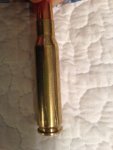Hey guys.
So I have a brand new never fired rem700 AAC-SD .308 s/a 20". I sent the bolt out to have pcr install one of their knobs and it looks amazing. So tonight I decided I wanted to load the mag and just cycle the rifle to see how everything felt, mind you not firing the rifle. Only chambering and ejecting a few rounds to make sure everything was working smoothly...it's not. The gun is new. Not a single shot has been put down it since It was purchased. Here are the issues. Rounds go perfectly into the box mag. Now when you try to chamber a round quickly it feels almost as if the round is getting hung up on something But if u do it slowly. They chamber fine. Ok all is good. Now they eject good and all. Not super strong. But what you would expect from a stock remington. Now checking out the round after ejection. I notice two gouges the length if the case. Same spot on all rounds. Now I'm not some well versed rifleman but this doesn't seem right. Anyone have any ideas on what's going on?
Thanks
Phill
So I have a brand new never fired rem700 AAC-SD .308 s/a 20". I sent the bolt out to have pcr install one of their knobs and it looks amazing. So tonight I decided I wanted to load the mag and just cycle the rifle to see how everything felt, mind you not firing the rifle. Only chambering and ejecting a few rounds to make sure everything was working smoothly...it's not. The gun is new. Not a single shot has been put down it since It was purchased. Here are the issues. Rounds go perfectly into the box mag. Now when you try to chamber a round quickly it feels almost as if the round is getting hung up on something But if u do it slowly. They chamber fine. Ok all is good. Now they eject good and all. Not super strong. But what you would expect from a stock remington. Now checking out the round after ejection. I notice two gouges the length if the case. Same spot on all rounds. Now I'm not some well versed rifleman but this doesn't seem right. Anyone have any ideas on what's going on?
Thanks
Phill






